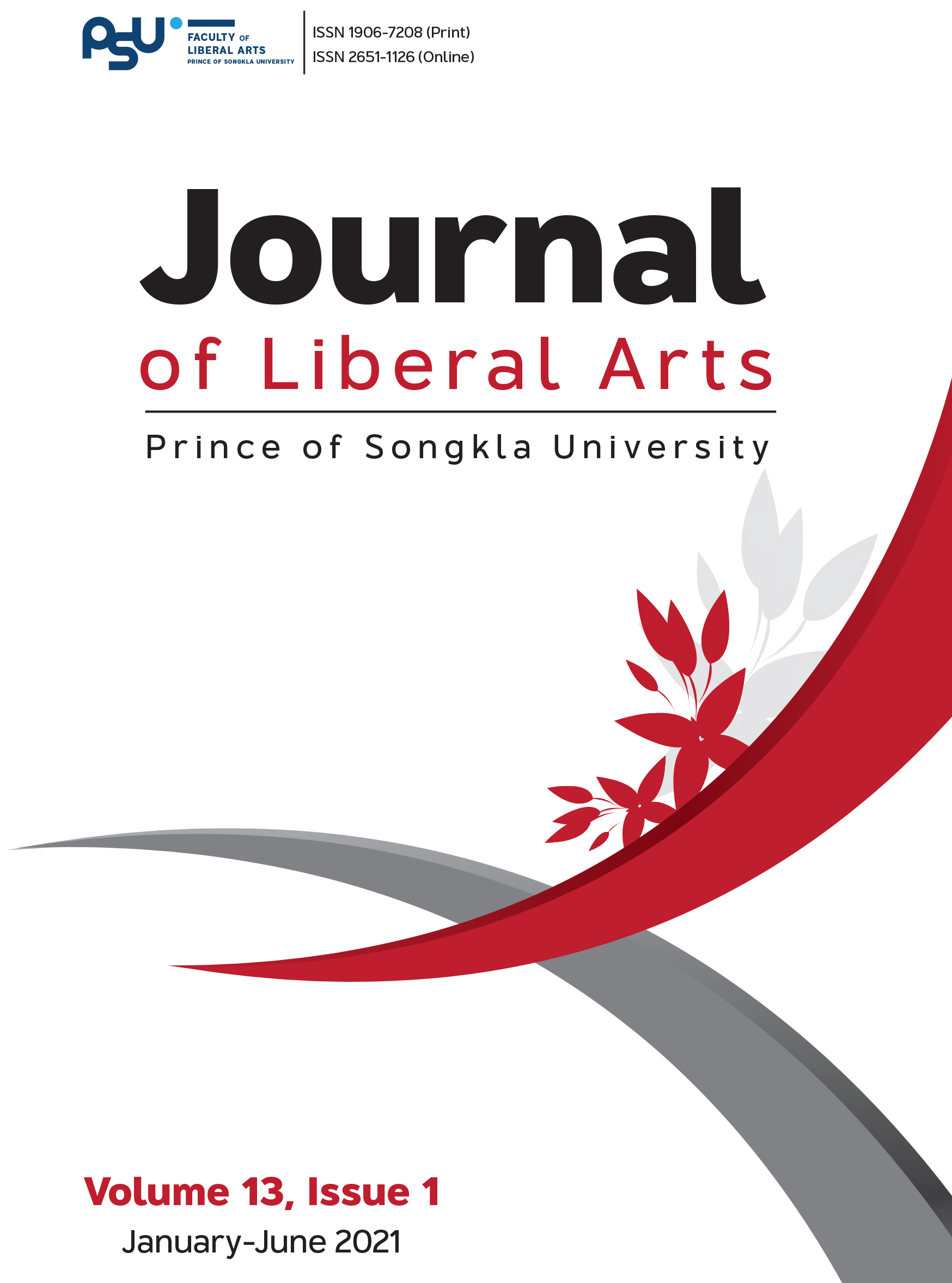A Transitivity Analysis of the Experience of Depression as Expressed on Thai Twitter
Keywords:
depression experience, discourse analysis, transitivity, Twitter, type of processAbstract
Twitter is an online platform where users can express their experiences and opinions. Depression is conveyed on Twitter through a writer’s point of view. Transitivity analysis examines the verbal choices a speaker or writer makes to reflect their view of a given situation. This study focused on a transitivity analysis of the experience of depression as seen on Thai Twitter. Transitivity was analyzed in 200 tweets (Twitter messages) with the hashtags #ซึมเศร้า [sµmsaßw] (#depression) and #โรคซึมเศร้า [roßoksµmsaßw](#depressivedisorder). The analysis focused on the types of processes represented in the tweets, with the results demonstrating six such processes: mental, behavioral, material, existential, relational, and verbal. In the 200 tweets examined, 642 verbs were present. The most frequent type of process found was mental (38.94%), followed by behavioral (26.79%), material (12.62%), relational (7.63%), verbal (7.17%), and existential (6.85%). The results indicate that mental processes were found most frequently to represent negative feelings in various words and phrases such as want to cry, upset, and painful; for behavioral processes, cry and unintentionally laughing on the outside; for material processes, destroyed and used to be bullied; for existential processes, to exist; and for verbal processes, beg and complain. This transitivity analysis reflects the experience of depression as it is expressed on Twitter. The verbal choices in these tweets can function as indicators of depressive disorder.
References
Angkapanichkit, J., et al. (2019). Language, communication and depression: An exploration of communicative practices about depression for sustainable quality of life of Thai adolescents. Thailand Research Fund. [in Thai]
Bury, M. (2001). Illness narratives: Fact or fiction? Sociology of Health & Illness, 23(3), 263-285. https://doi.org/https://doi.org/10.1111/1467-9566.00252
Coppersmith, G., Dredze, M., & Harman, C. (2014). Quantifying mental health signals in Twitter. Proceedings of the Workshop on Computational Linguistics and Clinical Psychology: From Linguistic Signal to Clinical Reality.
Demjen, Z. (2014). Drowning in negativism, self-hate, doubt, madness: Linguistic insights into Sylvia Plath's experience of depression. Commun Med, 11(1), 41-54. doi:10.1558/cam.v11i1.18478
Eichstaedt, J. C., Smith, R. J., Merchant, R. M., Ungar, L. H., Crutchley, P., Preoţiuc-Pietro, D., Asch, D. A., & Schwartz, H. A. (2018). Facebook language predicts depression in medical records. Proceedings of the National Academy of Sciences, 115(44), 11203-11208. https://doi.org/10.1073/pnas.1802331115
Ezzina, R. (2015). Transitivity analysis of «The Crying lot of 49» by Thomas Pynchon. International Journal of Humanities Cultural Studies, 2(3), 283-292.
Fosgerau, C. F., & Davidsen, A. S. (2019). Patients’ representations of depressive symptoms and physicians’ responses in clinical encounters. Communication Medicine, 15(1), 28-39.
Fowler, R. (1986). Linguistic criticism. Oxford University Press, USA.
Halliday, M., Matthiessen, C. M., & Matthiessen, C. (2014). An introduction to functional grammar (2nd ed.). Routledge.
Halliday, M. A., & Matthiessen, C. (2004). An introduction to functional grammar(3rd ed.). Edward Arnold.
Karimi, N., Lukin, A., Moore, A. R., Walczak, A., & Butow, P. (2018). Advanced cancer patients’ construction of self during oncology consultations: A transitivity concordance analysis. Functional Linguistics, 5(1), 6. doi:10.1186/s40554-018-0057-9
Levin, B. (1993). English verb classes and alternations: A preliminary investigation. University of Chicago Press.
Matley, D. (2018). “Let's see how many of you mother fuckers unfollow me for this”: The pragmatic function of the hashtag #sorrynotsorry in non-apologetic Instagram posts. Journal of Pragmatics, 133, 66–78. doi:https://doi.org/10.1016/ j.pragma .2018.06.003
Ong’onda, N. A. (2016). Transitivity analysis of newspaper headlines on terrorism attack in Kenya: A case study of Westgate Mall, Nairobi. International Journal of Humanities and Social Sciences, 6(9), 77-85.
Pan, J., Liu, B., & Kreps, G. L. (2018). A content analysis of depression-related discourses on Sina Weibo: Attribution, efficacy, and information sources. BMC Public Health, 18(1), 772. doi:10.1186/s12889-018-5701-5
Razak, C. S. A., Zulkarnain, M. A., Hamid, S. H. A., Anuar, N. B., Jali, M. Z., & Meon, H. (2020). Tweep: A system development to detect depression in twitter posts. In R. Alfred, Y. Lim, H. Haviluddin, & C. K. , Computational Science and Technology. Singapore.
Siriumpankul, A. (2018). Depression and social media behavior. Panyapiwat Journal (10(Special)), 327-337. Retrieved from https://so05.tci -thaijo.org/index.php/pimjournal/article/view/137336
WHO. (2018). Depression and other common mental disorders: Global health estimates. Retrieved from https://apps.who.int/iris/bitstream/handle/10665/254610/WHO-MSD-MER-2017.2-eng.pdf?fbclid=IwAR3PyoyEKSuXy-inTTwBgfTVaadC2sMCmaZswsERMMY4Ojr7FgcQts3GB8
Yiemkuntitavorn, S. (2005). Thai transitivity: A Functional grammar analysis. Unpublished doctoral dissertation, University of Tasmania, Australia.
Zappavigna, M. (2018). Searchable talk: Hashtags and social media metadiscourse: Bloomsbury Publishing.
Zappavigna, M., & Martin, J. R. (2017). #Communing affiliation: Social tagging as a resource for aligning around values in social media. Discourse, Context & Media. doi:10.1016/j.dcm.2017.08.001
Zhang, Y. (2017). Transitivity analysis of Hillary Clinton’s and Donald Trump’s first television debate. International Journal of Applied Linguistics and English Literature, 6, 65. doi:10.7575/aiac.ijalel.v.6n.7p.65
Downloads
Published
How to Cite
Issue
Section
License
The authors retain the copyright to their article but the Journal of Liberal Arts, Prince of Songkla University reserves the exclusive rights to first publication.






